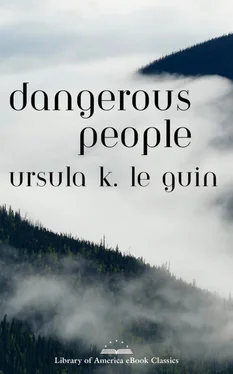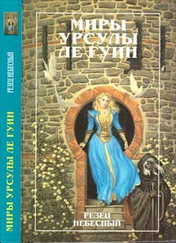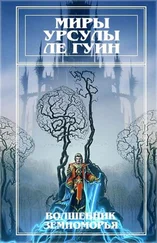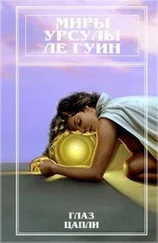Ursula K. Le Guin
DANGEROUS PEOPLE
Brian Attebery, editor
DANGEROUS PEOPLE
By Arravna
NOBODY KNOWS WHY the house named Hardcinder stands by itself on a rise of slaggy basalt, inside the curve of the other houses of that arm of the town. [1] Kesh towns were built on the pattern of the heyiya-if, two spiral curves with a common center or Hinge. The Four-House (sacred) arm consisted of the five heyimas or sacred meeting-places, the Five-House (secular) arm consisted of dwelling-houses, spaced out in a curve surrounding a common place or plaza. There were so many houses in Telina that the secular arm had become three arms, outer, middle, and inner, each curving around its own plaza. (Note that lower-case “house” means a dwelling-house; upper-case “House” refers to the Nine Houses into which the Kesh divided all being.)
Maybe at some time they enlarged the common place of Telina [2] The largest and most prosperous town of the central Valley, lying between the Old Straight Road and the River Na.
but left the old house standing the way it does, sticking out into the common; or maybe some hard-headed people built the house there on the common because they wanted a foundation of rock. Nobody knows now. What happened a long time ago, or even not long ago at all, even what happens now, is a matter of memories and inventions and mostly has to be taken on somebody’s word.
So I give you my word: [3] A pun both on the meaning of the phrase and on the author’s name, Arravna, River of Words.
a good many years ago [4] A familiar literary evasion, understood to mean that though Hardcinder House is a real house, the characters are fictional and the story is a fiction (possibly with some historical or legendary basis).
a family [5] Marai, household, means any number and any combination of blood kin and married-ins living in one house. The Kesh were matrilocal, and house ownership matrilineal, so a mother or grandmother was likely to be at least nominally the head of the family, responsible for the upkeep of the house and the behavior of family members.
was living upstairs in Hardcinder House, in the five southeast rooms with the deep balcony that goes around the corner of the house. The railing of the balcony is carved with grape stakes and grape vines and goats kneeling and standing up to eat the grapes. The children who grew up there knew each wooden goat, the grinning billy, the staring kid, the dancing nanny with her tongue sticking out, the lopsided goat missing one horn, cracked off maybe by some other child playing there some other time. A little girl [6] Shamsha, the grandmother at the time of the story.
who lived in that household thought the grinning goat kept his mouth open because he was hungry for the wooden grapes that hung just out of his reach, so she put wild oats and parsley in his wooden mouth. Later on, her little son found the fat flank of the dancing nanny a place of comfort to lean on when he needed comforting, and soon after that, her little daughter tried hard to break the one horn off the one-horned goat so it would come out even, but she couldn’t do it. A few years later there was a second daughter waving her legs and reaching her arms out to the goats and the grapes. And a few more years later the children of those two daughters were hauling themselves up to stand by holding on to the wooden leaves, learning how to walk, running about the balcony, feeding the he-goat wild oats and parsley. So Shamsha saw green stuff drooping out of his mouth as she came back from the Oak Society workshop, and said, “Still hungry, are you, goat?” The goat grinned. Shamsha stood a moment at the railing looking down at the common where her grandchildren and other children were playing, and then went indoors, eager for shade and cool water. It was a hot afternoon in a hot summer.
Nobody was in the house but Shamsha’s elder daughter’s husband Vavetaiveda, asleep on the front-room windowseat. As she walked across town, Shamsha had imagined lying down on that windowseat where the south wind would flow sweetly over her. She had a long drink of water from the cooler [7] Water was piped into Kesh town-houses, which had interior flush toilets, sinks, and baths. Drinking water was kept cool in summer by various devices, often large earthenware storage jars that cooled by evaporation, fitted with a faucet.
and went on to her own room to lie down, but it was so close and stuffy there that she soon got up, bathed and changed, and went into the kitchen. She was restless, wanting work to do. She was chopping mint and chervil for salad when her younger daughter came into the room. Hwette did not speak. On the oaken counter, beside the board on which her mother was chopping herbs, she laid down a plant of chicory: the root, the tough stalk and leaves, the flower stalk at the top, all the flowers but one closed and that one closing, for it was late in the day and chicory is a morning flower. [8] Many wildflowers had symbolic meaning to the Kesh; chicory signified pregnancy. There are other significations. Hwette is in the morning of her life. The blue chicory flower will live only when growing untouched; if picked, it closes quickly and dies.
“That’s too old for salad, soubí!” [9] Sou = daughter, -bí attached to a word expresses affection.
said Shamsha. She looked around, but Hwette had already gone through to another room.
Shamsha went on chopping herbs, and put on a pot of cracked wheat to boil so it would be cool by dinner time, continuing to think about what concerned her. She had been for some years archivist of the Madrone Lodge, [10] Members of the Madrone Lodge undertook to keep records and archives and write chronicles and history either locally or for the Kesh people as a whole (in the latter case they worked at least part of the time in the Madrone Lodge Archives of Wakwaha). Because it dealt with the past, rather than with actuality, the Lodge was considered to belong to the Houses of Sky. Any person “living in the Sky Houses” was considered to be, to that extent, a “dangerous” person.
and last winter in the course of going through old gifts and holdings of the archives had become interested in a manuscript, unsigned, probably written a couple of lifetimes ago, called Controlling . It dealt with aspects of human behavior that interested her, and people of the Madrone and Oak [11] Shamsha is also a member of the Oak Society, in the Third House of Earth (Serpentine), made up of people interested in literature, written and oral. Closely connected to both Madrone Lodge and Oak Society was the Book Art, specifically concerned with the manufacture of paper, ink, paints, the tools of writing, printing, and visual art, and books of all kinds.
had agreed with her that it was a work of originality and insight, worth saving for a while. [12] Concerning the Kesh attitude towards preservation of documents, etc., see “Pandora Converses with the Archivist of the Library of the Madrone Lodge at Wakwaha-na,” pages 369–372.
She had been copying and editing it since before the Moon Dancing, [13] One of the seven annual wakwa hedou, great dances, the Moon was a festival of ritual license, the most “dangerous” of all the great dances. It went on for ten nights beginning at the second full moon after the vernal equinox—mid-Spring. The references place the time of the story as late May or June.
spending several weeks all told at the Exchange [14] The computer center at Wakwaha, installed and maintained by the super-terrestrial cybernetic/robotic network known to the Kesh as the City of Mind.
Читать дальше












